Introduction
Hindu Dharma has a glorious past of great Saints and Sages. Several Saints ascended to the state of Guru and showed the path of God realisation to many. They also taught spirituality to the society through their conduct and actions. Their mission was not just limited to spirituality but they also did substantial work for the defence of nation whenever it was in difficulties. Some of the Saints travelled all over the world and disseminated the spiritual knowledge of Bharat there without any personal expectations. Millions of people abroad are getting benefit of that. For last lakhs of years, the Sages took tremendous efforts to preserve the Vedic Knowledge which is the pride of Bharat. They also created many subjects connected with the human life and made it easy. The most important thing however is that the Saints of Bharat have donated the world the tradition of Guru-disciple.
The current scene however is different. The cricketers, movie heroes and heroines have become the ideals of Hindus. Also the two vices of selfishness and narrow mindedness have become dominant in Hindus which is causing lot of harm to Hindu society. Under such circumstances it has become essential to study and follow the life of Saints who have imparted the teaching of sacrifice, love. devotion to righteousness, devotion to nation, helping the society and kashtradharma( duty of a warrior). We are hereby publishing the matter related to them so that people should come to know about such great Saints. We pray at the feet of God that let Hindus get the inspiration to study and follow their biography and teachings.
Maharshi Vyas
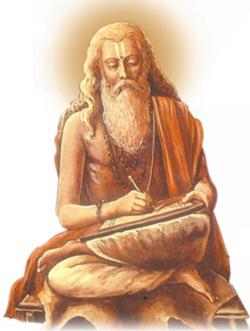 |
Jayanti
Vaishakh Shukla Trayodashi
Honour of being equal to Vishnu
Vyasaya Vishnu Roopaya, Vyasa Roopaya Vishnave |
Namove Bhrama Nithaye, Vasishtaya Namo Namaha:||
Meaning: Salutation to Vyas who is in the form of Vishnu and Vishnu who is in the form of Vyas and one who is the treasure house of the Vedas. Salutation to one who was born in the noble family of Vasishta. The honour of being equal to Vishnu belonged to Maharshi Vyas.
Work of Maharshi Vyas
In ancient days, our forefathers, the Rushis of Aryavarta, went to the forest to do Tapasya during the four months following Vyas Pournima – a particular and important day in the Hindu calendar. On this memorable day, Vyas, began to write his Brahma Sutras.
He studied the Shastras under Sages Sanaka and Sanandana and others. He arranged the Vedas for the good of mankind and wrote the BrahmaSutras for the quick and easy understanding of the Srutis; He also wrote the Mahabharata to enable women, shudras and other people of lesser intellect to understand the highest knowledge in the easiest way. Vyas wrote the eighteen Purans and established the system of teaching them through Upakhyanas or discourses. In this way, He established the three paths, viz., Karma, Upasana and Jnana. Vyas’ last work was the Bhagavat which He undertook at the instance of Devrushi Narad, who once came to Him and advised Him to write it as, without it, His goal in life would not be reached.
Writing of the world’s longest epic – Mahabharat
Maharshi Vyas knows the secret of all Creation. His vast knowledge of the past, present and future made Him apt to author the Mahabharat, the greatest epic in the Hindu scriptures. As Vyas knew all about prayers, Karma, Vedas, practice of asceticism and yog, Dharma (Religion and duty), Artha (material wealth) and Kama (desire), Shastras and the society, He put all this knowledge in the Mahabharat.
Vyas wanted someone to write the epic as He spoke the Shlokas to be included in the epic. So He went to Brahma and requested Him to provide Him a writer who would pen the epic. Brahma told Vyas that He should ask Ganapati to write the epic for Him. Ganapati agreed to write but on the condition that Vyas would not stop dictating even for a minute. Vyas also laid down His condition, “Whatever I say should be written only after comprehending its meaning thoroughly, not blindly scribbled.” Thus, Maharshi Vyas recited the Mahabharat, which has more than one lakh verses, without stopping even once, in order to fulfill Lord Ganapati’s condition!
Lord Ganapati had a sharp intellect. As Vyas kept reciting, He kept comprehending the meaning and writing it down. Vyas had no time to think. But He too was clever; when He needed time to mentally organise the next verse, He would recite a difficult verse, which could have two or three interpretations and hence, was difficult to comprehend at once. This would force Lord Ganapati to stop and ponder over its meaning and this gave Vyas the time to mentally compose the next few verses. In this manner the Mahabharat was recited by Vyas and written by Ganapati. That which is not found in the Mahabharat, is not found anywhere else in the world.
The world has nothing additional to speak of!
All that is written in this world is the uttering of Vyas; that is why it is said,
(Meaning – That which is spoken by the world, is nothing but the ‘left-overs’ of Vyas) – Gurudev Dr. Kate Swamiji.
Vyas is beyond Pravrutti and Nivrutti
‘Vyas’ is the line joining the centre point of a circular object to the circumference on both the sides. ‘Vyas’ brings about a division of the circular wheel of Creation. Maharshi Vyas touches both sides – these two sides are ‘Pravrutti’ and ‘Nivrutti’; and yet, He remains unbound by them – this is the reason He is known as ‘Vyas’.
– Shankaracharya, Karveerpeeth, Kolhapur.
Maharshi Vyas – A Chiranjeevi
Vyas is considered by all Hindus as a Chiranjeevi – one who is still living and roaming throughout the world for the well-being of His devotees. It is said that He appears to the true and the faithful. Thus, in short, Vyas lives for the welfare of the world. Let us pray for His blessings on us all and on the whole world!
(Compiled by: Ms. Nandita Verma, Sanatan’s Ramnathi Ashram, Goa.)

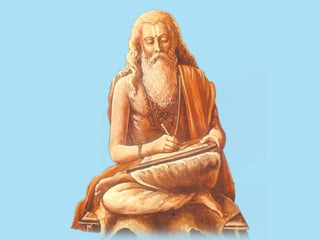
 Swami Vivekananda
Swami Vivekananda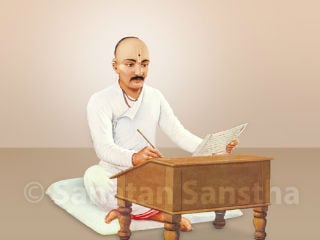 Sant Eknath (1533-1599)
Sant Eknath (1533-1599)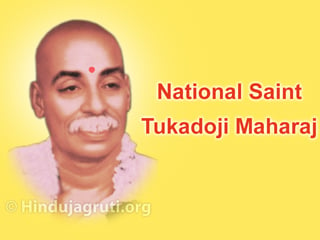 Saint Tukdoji Maharaj
Saint Tukdoji Maharaj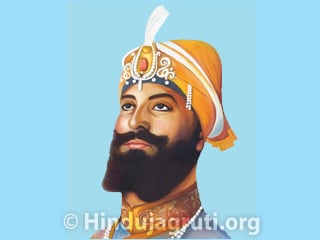 Guru Gobind Singh : Founder of Khalsa
Guru Gobind Singh : Founder of Khalsa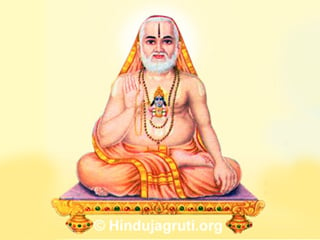 Shri Raghavendra Swami : A Great Devotee of Shri Vishnu
Shri Raghavendra Swami : A Great Devotee of Shri Vishnu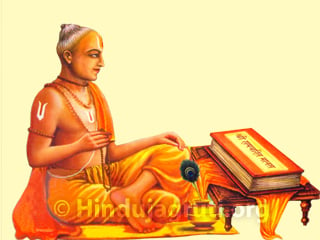 Sant Tulsidas: Great devotee of Deity Ram in Kaliyug
Sant Tulsidas: Great devotee of Deity Ram in Kaliyug